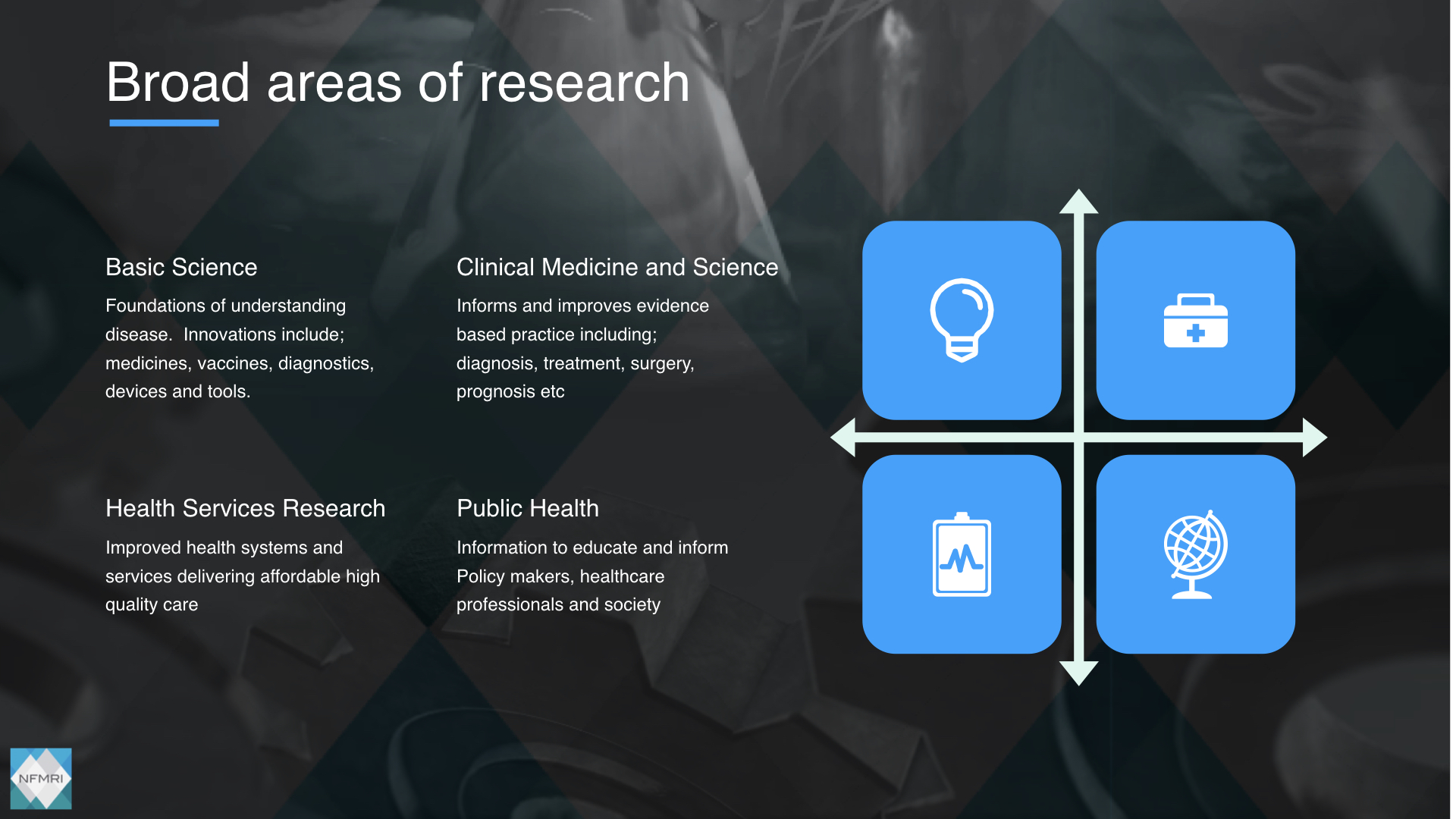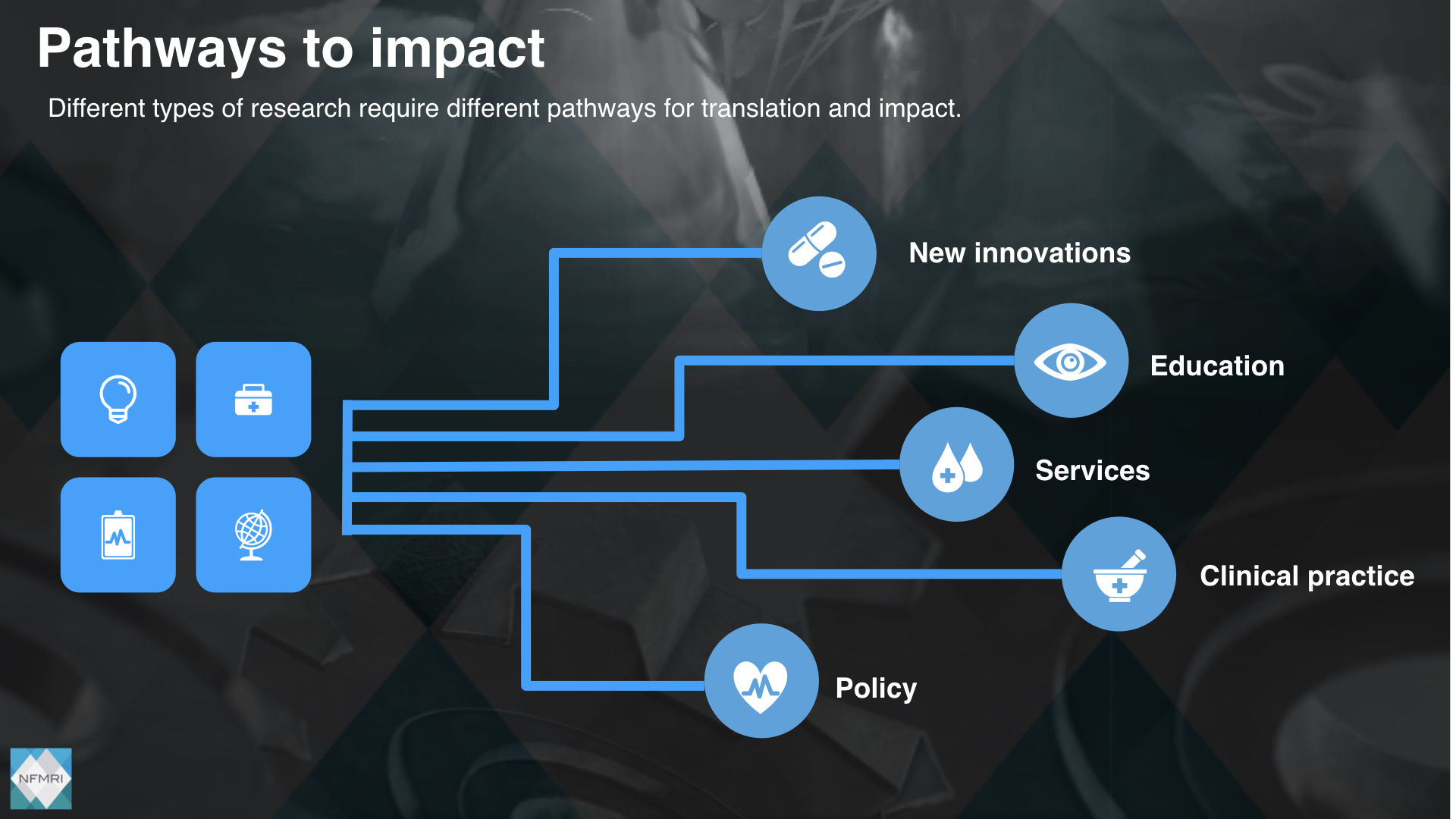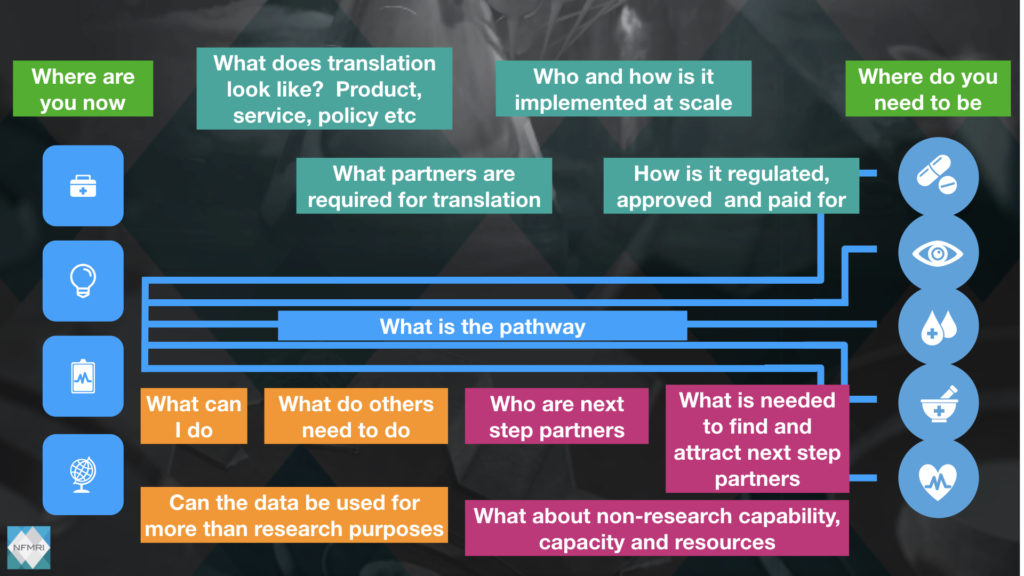Dr Noel Chambers
Research translation can be defined as passing along knowledge for the purpose of putting it into practice where communities benefit.
Before I dig deeper, it is important to note that basic blue sky research is a critical component of translation. Without it, there would be nothing to translate. Capability and capacity building is also crucial as it provides the foundation for research and translation including people, infrastructure, administration and equipment.
In this piece, I will focus on translating research towards delivering a community benefit; a for-purpose consideration beyond discovery and exploration where existing data supports further consideration and research focused on the delivery of potential ’impact’ to assist communities.
We shouldn’t lose sight of the reason our communities support medical research. It is more than just hope, but real community impact that maintains their support, not only via gifts and donations, but also via their tax dollars.
Researchers, institutions and intermediaries including trusts, foundations and charities should not consider themselves the intended recipients of philanthropy, but rather the entrusted conduit to delivering a greater community benefit.
Not all research is the same
Research has many faces. It can provide data to support:
- Reducing risk to patients and practitioners,
- The provision of new or better health services for specified populations and geographies,
- Improved clinical interventions and techniques,
- Opportunities for preventative health practices,
- The development and regulation of new products,
- Cost-effectiveness analysis, and more
Research can also provide data to show that something doesn’t work or that the status quo remains the preferred intervention.
The NHMRC uses the Australian and New Zealand Standard Research Classification system to identify four Broad Research Areas:
- Basic Science,
- Clinical Medicine and Science,
- Health Services Research, and
- Public Health
These four Broad Areas of Research relate to the type of research undertaken and give an indication of how the research may be translated and applied.
Not all research is the same. The way it is applied and the translational pathways and requirements need to be considered differently.

An understanding of the type of research that is being supported will not only influence what success might look like, but should also be considered when developing the application and review criteria, metrics for progress and reporting, as well as where your support is strategically applied along the translational pathway.
Different types of research require different pathways for translation and impact. Developing new vaccines is different from preventing needle-stick injuries, changes in surgical techniques and better heath services for remote communities.

Beyond discovery and basic science
Understanding the details of where you ‘need to be’ to complete translation and ‘how to get there’ can be complex. Translation, including planning, often involves the need to include external capability, capacity, experts, networks and partners and this is not normally in place when publicly funded research organisations apply for support.
For funders of research some fundamental concepts may assist in identifying and assessing where your support can best be applied to support translation.
It is unlikely that any funder can support the entire translational pathway effectively. Analysis of systematic gaps should not only consider the amount of support that is provided, but also how it is directed and can be used to attract other support including non-research support.
Defining your giving strategy with a focus on translation can assist in establishing your outreach mechanisms, application processes, review systems and metrics.
What does success look like?
- What is the unmet need or problem it addresses?
- Is it a product, service, tool, policy change, practice change or education program?
- Is it scalable and what communities, geographies may benefit?
- What are the regulatory and approval processes required?
- Who will ultimately implement the outcomes, government, industry, community groups or other?
Where are you now?
Understanding what translation looks like and how it will be implemented provides guidance in understanding of where the research is now? My experience is that this can be the harder question.
Some considerations may include:
- Is the outcome really addressing an unmet need?
- Is the outcome trying to improve current or emerging interventions? Which ones?
- Who is in need?
- Why is it better, what are the competitive advantages?
- Has the target or early data been validated?
- What evidence exists to support efficacy, safety and competitive advantage?
- Has the data been verified (repeated) by other groups?
- Does the data comply with quality assurance systems so it can be used in regulatory and approval processes? Would it pass an audit?
- What research needs to be repeated?
- What experience, structures and non-research support is available to enable engagement and progress to next-step partners.
Next-step partners
Translation often needs next-step partners. Research data very rarely translates and scales directly from the lab to patients, practitioners and other users directly.
Next-step partners bring resources, networks, capability and capacity essential for completing translation.
In this sense, research translation can often be viewed along the lines of a business-to-business -to-consumer (B-B-C) model.
These next-step partners can include government and communities, industry and investors as well as other organisations that bring resources, expertise, networks, capability and capacity that can help navigate the regulatory, approval and reimbursement processes.
Considering this pathway means that researchers and their institutions need to think beyond typical research activities to:
- Identify who next-step partners may be?
- What are those next-step partners looking for?
- What pre-requisites research and non-research requirements may exist?
- Can you attract the next-step partners and compete with other opportunities?
- What perceived and real barriers exist for uptake?
- There are many competing opportunities across many conditions out there. Why this opportunity?
- Do you have expertise, networks, capability and capacity in engagement, business development and negotiation etc?
By understanding next-step partners needs early, research resources, directions and activities can be applied efficiently and effectively.
Without attracting next-step partners, opportunities may wither on the vine and may even cause harm. There is little doubt that potential interventions are contained in academic literature where the opportunity for translation has been missed.
Translation requires teams
Translational pathways are also not always the same and require differing non-research activities.
Translation may require skills and implementation capabilities, including commercialisation and business development, regulatory skills, community outreach and education, marketing and media, policy development, physician and allied health practitioner training, lobbying and service delivery.
The health system is highly regulated providing safety, efficacy and cost oversight. Reaching the end point of the translational pathway where impact is realised, may also include navigating and working with regulators, health departments, government, industry, investors, oversight committees and peak bodies.
Consumers and payers may not be who you think they are. Your immediate consumers may be your next-step partners (B-B-C model) who ultimately need financial returns or savings. These considerations extend beyond “will my product or service be approved for use to reimbursement and other pharmacoeconomic decisions”.
Most PFROs have technology transfer offices (TTO) in place. These offices engage with next-step partners, including industry and venture capital, helping to commercialise intellectual property arising from research. They play a vital role in translation, but can often be under-resourced.
I am not aware of any PFRO with an engagement office assisting in the systematic translation of research that is not commercialised and may require policy change, advocacy or developing community intervention and outreach programs.
While funders of research may be restricted to providing grants for research-only purposes, they might wish to consider how funding may influence the attainment of both research and non-research support when needed for translation. They may also wish to consider if they can play a direct role in translation.
Translation also requires research collaboration and outsourcing. From accessing established research models, utilising quality systems, expanding field-of-research, discipline or disease capability and biostatistics to multi-centred clinical trials.
Funders have the opportunity to consider activities beyond the ‘research silo’ to help researchers address the critical translational questions in a way that is meaningful to attracting next-step partners. Research efficiencies and trust can be increased by partnering with established research groups rather than recreating the wheel. Data integrity questions and challenges with irreproducible results can be assisted by external validation and collaborative results.
Effective and efficient support
For funders of research some fundamental questions and concepts may assist in identifying and assessing opportunities for support.
Strategically supporting research opportunities to fulfil your purpose takes planning, work and continual improvement.
Identifying the intent of specific funds and how they will be applied can help to not only identify opportunities, but also the development and implementation of application and review processes and inform metrics to measure progress and success.
Translational research activities and metrics should be guided by supporting systems that prioritise purpose and efficiencies, reduce wastage, as well as the eventual cost and time to deliver potential benefits. While important, we should be careful that spillover benefits don’t obfuscate the intent or direction of the research.
For efficient and effective translational research programs, we should explore a ‘kill-it-quick’ approach where research is directed not only at ‘will it work’ questions, but also at ‘will it fail’ questions.
If the support is focusing on a key research question (or two) knowing how the question fits into the translational pathway along with other research and translation activities can help.
Opportunities with longer-term support can benefit from a go, no-go approach and milestone-focused metrics. Project planning can identify key milestones that can be assessed and trigger next tranche funding depending upon the outcomes. If using this approach, exit strategies and alternatives to exit are important to consider early, remembering that research can fail and there is potential for harm.
When seeking and evaluating opportunities for support, consider research and non-research activities, capability and capacity to support translation. The potential for translation and attracting next-step partners is critical and culling opportunities early based upon weakest links can help manage resources by administrators, reviewers and researchers.
Translation combines many fields of research and non-research skills. If your focus is on translation, your evaluation and review criteria should be built for purpose. The questions asked may not be traditional academic research grant questions. Instead they may extend beyond research and require input from other groups such as the TTO.
NFMRI’s approach
NFMRI focuses on the translation of basic science where translation leads to the development of new medicines, vaccines, biologicals, devices, diagnostic and other applied tools.
We don’t support other areas of research and have built specific application and review processes, expertise, supporting infrastructure and metrics around a defined strategy focused on where and how support is provided to assist research discoveries advance (or fail early) towards attracting next-step partners.
As our conference demonstrates,we work both upstream with institutions and researchers and downstream with next-step partners including academia, philanthropy government, industry, and investors.
We continue to learn and are pleased we are building a sound evidence base, demonstrating that the strategy and systems employed have achieved success across diseases, conditions and innovation types.
Built upon this success we are expanding our partnership model.
Have you considered?
- If translation isn’t supported when opportunities exist, can it cause harm to the communities we are trying to help?
- Should I fund a student to do research that would set up a new model or support outsourcing the study to an established, recognised collaborator with an existing, trusted and proven model?
- Are quality systems important to this component of research? Would the research need to be repeated for its results to be trusted by investors?
- If there isn’t any non-research support available to assist translation, should I fund another project where support does exist?
- Is the clinical trial design and size able to meet the needs of regulators for approval and subsequent audit?
- How will this research scale, where and how?
- What evidence is there to support the competitive advantage?
- There are many possible research questions. Are the right questions being prioritised?
- Are metrics and rewards for project progress, researchers, institutions and funders aligned to prioritise purpose or something else?
- Are review systems considering research and non-research capability and capacity required for translation?

